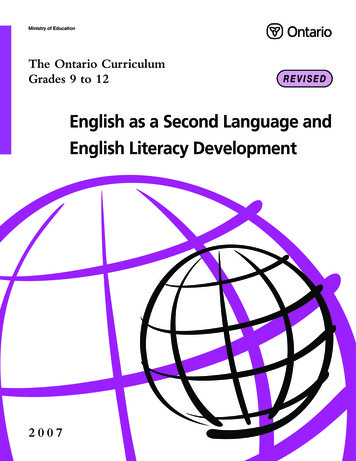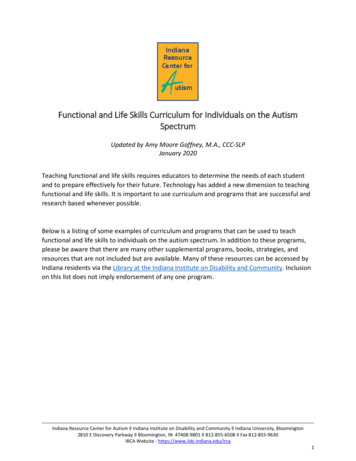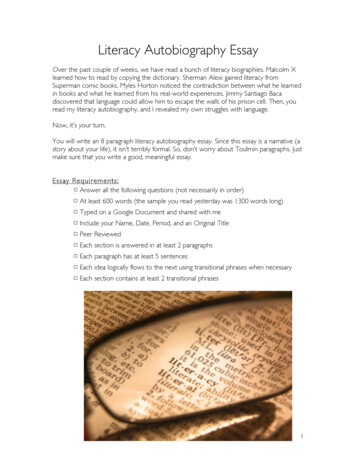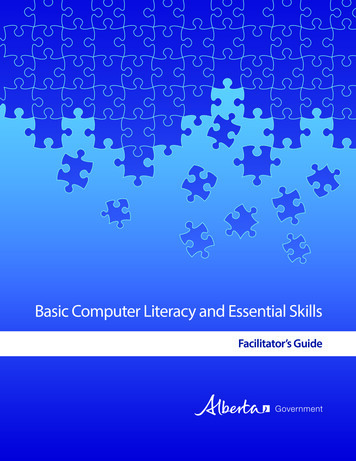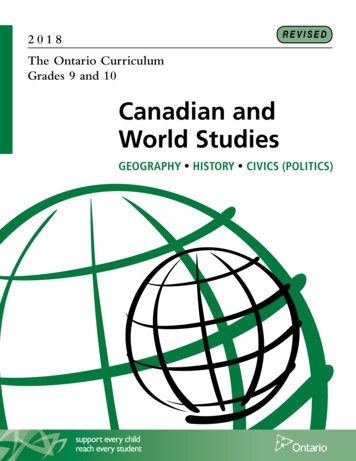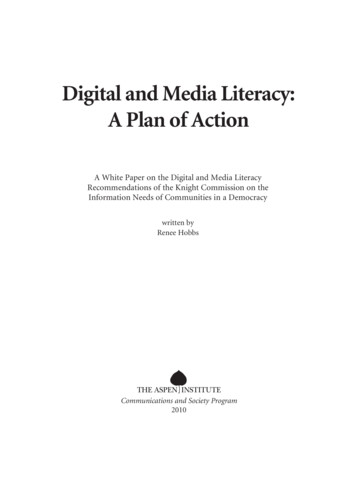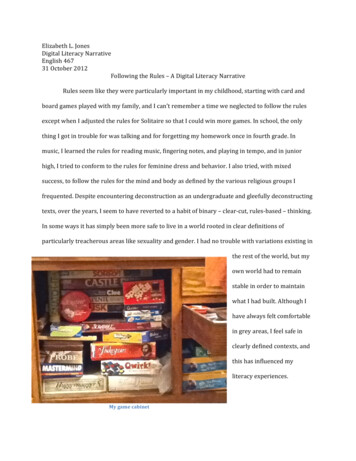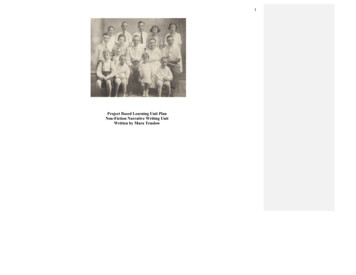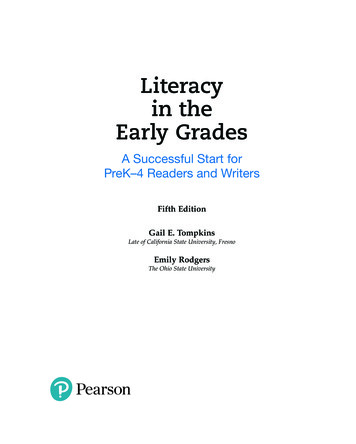
Transcription
Literacyin theEarly GradesA Successful Start forPreK–4 Readers and WritersFifth EditionGail E. TompkinsLate of California State University, FresnoEmily RodgersThe Ohio State UniversityA01 TOMP0569 05 SE FM.indd 120/12/2018 17:43
Director and Publisher: Kevin DavisPortfolio Manager: Drew BennettManaging Content Producer: Megan MoffoContent Producer: Yagnesh JaniPortfolio Management Assistant: Maria FelibertyManaging Digital Producer: Autumn BensonDigital Studio Producer: Lauren CarlsonExecutive Development Editor: Linda BishopExecutive Product Marketing Manager: Krista ClarkProcurement Specialist: Deidra HeadleeCover Design: Pearson CSC, SPi GlobalCover Art: Pearson CSCFull Service Vendor: Pearson CSCFull Service Project Management: Pearson CSC,Vanitha PuelaEditorial Project Manager: Pearson CSC,Clara BartunekPrinter-Binder: LSC CommunicationsCover Printer: Phoenix ColorText Font: Palatino LT ProCredits and acknowledgments for materials borrowed from other sources and reproduced, with permission, inthis textbook appear on the appropriate page within the text.Every effort has been made to provide accurate and current Internet information in this book. However, theInternet and information posted on it are constantly changing, so it is inevitable that some of the Internetaddresses listed in this textbook will change.Copyright 2020, 2016, 2012 by Pearson Education, Inc. 221 River Street, Hoboken, NJ 07030. All rightsreserved. Printed in the United States of America. This publication is protected by Copyright and permissionshould be obtained from the publisher prior to any prohibited reproduction, storage in a retrieval system, ortransmission in any form or by any means, electronic, mechanical, photocopying, recording, or likewise. Toobtain permission(s) to use material from this work, please visit http://www.pearsoned.com/permissions/.Library of Congress Cataloging-in-Publication DataNames: Tompkins, Gail E; Rodger, Emily, author.Title: Literacy in the early grades: a successful start for preK-4 readersand writers / Gail E. Tompkins.Description: Fifth edition. Upper Saddle River, New Jersey : PearsonEducation, Inc., 2019. Includes bibliographical references and index.Identifiers: LCCN 2018041392 ISBN 9780134990569 ISBN 0134990560Subjects: LCSH: Language arts (Preschool) Language arts (Elementary) Language arts (Early childhood) Children—Language. Child development.Classification: LCC LB1576 .T6575 2019 DDC 372.6/049—dc23 LC record available at https://lccn.loc.gov/2018041392118ISBN-13: 978-013-499056-9ISBN-10: 013-499056-0A01 TOMP0569 05 SE FM.indd 221/12/18 9:21 AM
Pearson Education dedicates this bookto Gail E. Tompkins, one of our most gifted writers.Her talent was valued not only by Pearson but also bymany literacy and language arts professors who recognized her abilityto make research practical and teaching accessible for their students.Gail understood the literacy needs of childrenand also the essential role teachers play in meeting those needs.She masterfully wrote and deeply cared about both.A01 TOMP0569 05 SE FM.indd 320/12/2018 17:43
For my nephew Travis and his wife Andrea;and for all the other early career teachers who, like them,are making a difference in thelives of their students.Emily RodgersA01 TOMP0569 05 SE FM.indd 420/12/2018 17:43
Dear Reader,I was delighted to be invited to co-author this new edition of Literacy in the Early Grades:A Successful Start for PreK-4 Readers and Writers with Gail Tompkins. Gail’s textbooks forpreservice teachers are so well-respected for their depth and detail; as a college professormyself, I leapt at the chance to work alongside her. Sadly, I didn’t get a chance to meet Gail;she passed away just as our work together on this text was getting underway. However,after a year immersed in co-authoring this text I feel I know Gail very well. We couldn’tcollaborate in person or on the phone or via Skype as I was imagining we would, but everytime I opened a chapter file to work on, I felt I was in close dialogue with her. Gail’s voiceis that personal, that caring, about preparing expert literacy teachers of young children.Like Gail, I was a teacher for several years before undertaking a doctoral degree andeventually going on to earn a position as a professor in a college of education. I started outteaching in a third-grade classroom; it was a beautiful group of young students who taughtme so much about the range and variation of strengths, needs, and interests that exist in oneclass. I can still name all 28 students! (You never forget your first class!)Though I loved teaching third grade, I became increasingly interested in what thereading specialist was doing with my students when they left my classroom for additionalinstruction. I realized I really wanted to be the specialist who worked with students whoneeded something more than classroom instruction. That interest led me to pursue a specialeducation degree in reading, and then I spent several years working with 6th–8th graderswho were struggling with classroom instruction.In my new position as a remedial reading teacher, I learned a lot about assessment,diagnosis, and planning instruction. I also learned something else that led me to a third career change: while studying the records of my 6th–8th grade struggling readers, I realizedthat nearly every single one of the cumulative records contained teacher comments goingas far back as kindergarten identifying reading and writing difficulties. I realized that itwas possible to see the trajectory of reading progress going off course at a very early age,and I also realized the importance of early literacy instruction. I also learned that if youngstudents are on a successful track early on, they almost certainly will stay on that trackthroughout the grades. However, young students who are struggling early on will almostcertainly continue to struggle unless they have expert instruction from their teachers tohelp them catch up.These realizations about the importance of becoming literate and of closing gaps assoon as they appear spurred me on to study early literacy at a doctoral level. I was fortunateto study at The Ohio State University and to become involved in Reading Recovery at OSUas a trainer of teacher leaders for 15 years. In my role as a faculty member at Ohio State, Ihave continued to work closely with teachers and young children; I wouldn’t have it anyother way.As a teacher of young children, you have in your hands a remarkable opportunity tohelp beginning readers and writers become literate early on. Know that as a classroomteacher you are your students’ first tier of instruction and you are responsible for each andevery student in your classroom. Know too that you can make an incredible difference inthe lives of young individuals who will soon (perhaps sooner than you can imagine) be college and career ready high school students, due in no small part to your early efforts to setthem on a strong path to becoming literate.This textbook, rich in theory and instruction, will help prepare you for that awesomejob. I invite you to dialogue with Gail and me, as you read these chapters. Every word iswritten with you in mind.Emily RodgersColumbus, OhiovA01 TOMP0569 05 SE FM.indd 520/12/2018 17:43
A01 TOMP0569 05 SE FM.indd 620/12/2018 17:43
Brief Contents1Becoming an Effective Teacher of Reading2Examining Students’ Literacy Development333Assessing Students’ Literacy Development644Cracking the Alphabetic Code935Learning to Spell1236Developing Fluent Readers and Writers1477Building Students’ Vocabulary1728Teaching Comprehension: Reader Factors1989Facilitating Students’ Comprehension: Text Factors22710Scaffolding Students’ Reading Development25811Scaffolding Students’ Writing Development29112Integrating Literacy Into Thematic Units3234Compendium of Instructional Procedures348Glossary379Index382viiA01 TOMP0569 05 SE FM.indd 720/12/2018 17:43
A01 TOMP0569 05 SE FM.indd 820/12/2018 17:43
ContentsIntroducing Ms. Janusz and Her Second Graders 14How Students Develop as Readers and WritersStage 1: Emergent Reading and WritingStage 2: Beginning Reading and WritingStage 3: Fluent Reading and Writing49495759Learning Outcomes4Chapter Review62Theme 1: Learning and Learning to ReadPrinciple 1: Effective Teachers Are KnowledgeableAbout LearningPrinciple 2: Effective Teachers Create a Communityof LearnersPrinciple 3: Effective Teachers Support Use of theCueing Systems6Accountability Check62References621Becoming an Effective Teacher ofReading6103Assessing Students’ LiteracyDevelopment6412Learning Outcomes64Theme 2: Effective Reading InstructionPrinciple 4: Effective Teachers Adopt a BalancedApproach to InstructionPrinciple 5: Effective Teachers Scaffold Students’Reading and WritingPrinciple 6: Effective Teachers Organize for LiteracyInstruction15Mrs. McNeal’s Second-Quarter Assessments64Classroom AssessmentStep 1: Planning for AssessmentStep 2: Assessing Students’ Progress Every DayStep 3: Evaluating Students’ LearningStep 4: Reflecting on Instruction6969707374Theme 3: Adjusting Instruction to Meet Students’ NeedsPrinciple 7: Effective Teachers Differentiate Instruction2323Teaching English LearnersBe Effective Teachers of Reading Interventions242426Diagnostic TestsDetermining Students’ Reading LevelsDiagnosing Students’ Strengths and Needs747578Teaching English LearnersEnglish Proficiency Screening8282Theme 4: Linking Assessment to Instructional PlanningPrinciple 8: Effective Teachers Link Instruction andAssessment28Chapter Review30High-Stakes TestingProblems With High-Stakes TestingPreparing for Standardized TestsThe Politics of High-Stakes Testing85858688Accountability Check30References30Portfolio AssessmentCollecting Work in PortfoliosInvolving Students in Self-AssessmentShowcasing Students’ Portfolios88898990Chapter Review91Accountability Check91References912Examining Students’ LiteracyDevelopment1517212833Learning Outcomes33Ms. McCloskey’s Students Become Readers and Writers33Promoting Students’ Oral Language DevelopmentOral Language ActivitiesEnglish LearnersThe Link Between Oral Language and LiteracyAssessing Students’ Oral Language3738383940Building Students’ Interest in Written LanguageConcepts About Written LanguageConcepts About WordsConcepts About the AlphabetManuscript HandwritingTeaching Students About Written LanguageAssessing Students’ Knowledge About Written Language414142444546494Cracking the Alphabetic Code93Learning Outcomes93First Grade Phonics Instruction93The Alphabetic PrinciplePhonological AwarenessPhonicsOrthographic Awareness96979898Developing Phonemic AwarenessWhy Is Phonemic Awareness Important?Using Phonemic Awareness StrategiesTeaching Phonemic Awareness Strategies989999100ixA01 TOMP0569 05 SE FM.indd 920/12/2018 17:43
x ContentsTeaching English LearnersPhonemic AwarenessAssessing Students’ Phonemic Awareness106106106PhonicsPhonics ConceptsPhonics Rules109109113Teaching PhonicsAssessing Students’ Phonics KnowledgeWhat’s the Role of Phonics in a Balanced LiteracyProgram?114118Chapter Review120Accountability Check120References1215Learning to Spell119123Writer’s Voice163Assessing Reading And Writing FluencyAssessing Reading FluencyAssessing Writing Fluency164164165Teaching English LearnersFluency168168Chapter Review170Accountability Check170References1707Building Students’ Vocabulary172Learning Outcomes172Mr. Wagner Teaches Vocabulary172Academic VocabularyThree Tiers of Words176177Teaching English LearnersVocabularyThe Development of Word KnowledgeWord ConsciousnessVocabulary Knowledge and Reading Achievement177177178179179Word-Study ConceptsSynonymsAntonymsHomonymsMultiple MeaningsFigurative Meanings180180181181181183Teaching Students About WordsWord WallsExplicit InstructionWord-Study ActivitiesWord-Learning StrategiesIncidental Word LearningAssessing Students’ Word Knowledge183184185185188190191Chapter Review195Learning Outcomes123Differentiating Spelling Instruction123Stages Of Spelling DevelopmentStage 1: Emergent SpellingStage 2: Letter Name-Alphabetic SpellingStage 3: Within-Word Pattern SpellingStage 4: Syllables and Affixes SpellingStage 5: Derivational Relations Spelling128128129129130130Teaching English LearnersSpelling131131Teaching SpellingMinilessonsWord WallsWord Study ActivitiesWeekly Spelling TestsWhat’s the Controversy About Spelling Instruction?133135135137140141Assessing SpellingDetermining a Student’s Stage of SpellingDevelopmentThe Instruction–Assessment Cycle142Chapter Review146Accountability Check195Accountability g Fluent Readers andWriters 1478Teaching Comprehension: ReaderFactors198Learning Outcomes198Learning Outcomes147Becoming Strategic Readers198Teaching High-Frequency Words147Reading FluencyAutomatic ReadingReading SpeedProsody151152159160What Is Comprehension?Reader and Text FactorsText ComplexityBefore Reading: Reader Factors to Consider203203204205Writing FluencyAutomatic WritingWriting Speed161161162Comprehension Strategies That ReadersUse While Reading206Teaching Comprehension StrategiesUsing Explicit Instruction215216A01 TOMP0569 05 SE FM.indd 1020/12/2018 17:43
ContentsxiTeaching for Comprehension During ReadingActivities That Promote Comprehension216219Reading Strategies and SkillsStrategies270270Teaching English LearnersComprehension And Reader FactorsAssessing Students’ Knowledge of Reader Factors220220222Chapter Review224Organizing for Instruction: Five approachesGuided Reading LessonsBasal Reading ProgramsLiterature Focus UnitsLiterature CirclesReading Workshop273274276280283286Chapter Review289Accountability Check225References2259Facilitating Students’Comprehension: Text Factors227Learning Outcomes227Learning About Frogs227Text Factors of StoriesFormats of StoriesNarrative GenresElements of Story StructureNarrative DevicesExamining Text Factors in a Story231231232235240240Text Factors of Informational BooksNonfiction GenresExpository Text StructuresNonfiction FeaturesExamining Text Factors in an Informational Book241241242244244Text Factors of PoetryFormats of Poetry BooksPoetic FormsPoetic DevicesExamining Text Factors in a Book of Poetry245245245246247Teaching about Text FactorsMinilessonsComprehension StrategiesReading and Writing ActivitiesAssessing Students’ Knowledge of Text Factors247248249249253Chapter Review254Accountability Check255References25510Scaffolding Students’ ReadingDevelopment258Accountability Check289References28911Scaffolding Students’ WritingDevelopment291Learning Outcomes291Participating in Writing Workshop291The Writing ProcessStage 1: PrewritingStage 2: DraftingStage 3: RevisingStage 4: EditingStage 5: PublishingAdapting the Writing Process for Young Students296296297298299302303Teaching WritingWriting Strategies and SkillsThe Six TraitsWriting Genres303304306307Teaching English LearnersWriting Development310310Assessing Students’ Writing311The Writing Process In ActionInteractive WritingWriting CentersWriting Workshop315315316317Chapter Review321Accountability Check321References32112Integrating Literacy IntoThematic Units323Learning Outcomes258Using the Reading Process258Learning Outcomes323The Reading ProcessStage 1: PrereadingStage 2: ReadingStage 3: RespondingStage 4: ExploringStage 5: Applying262263264268269269Creating Multigenre Projects323Connecting Reading and WritingReading to LearnWriting as a Learning Tool326327329Demonstrating LearningWriting Projects331331A01 TOMP0569 05 SE FM.indd 1120/12/2018 17:43
xii ContentsOral PresentationsMultigenre Projects334335Thematic UnitsHow to Develop a Thematic Unit336336Teaching English LearnersIntegrating Literacy Into Thematic UnitsTopics for Thematic Units337337339Chapter Review346A01 TOMP0569 05 SE FM.indd 12Accountability Check346References347Compendium of Instructional Procedures348Glossary379Index38220/12/2018 17:43
Special FeaturesTeacher AccountabilityMy Teaching To-Do ChecklistTeaching EffectivenessAssessment28Teaching Vocabulary90192Comprehension: Reader FactorsPhonemic Awareness 106Comprehension: Text FactorsCracking the Alphabetic CodeTeaching Spelling116Strategy Instruction144169Writing Instruction248272Instructional ApproachesReading and Writing Fluency215273320Common Core State StandardsConcepts About Written LanguageAssessment42Comprehension: Reader Factors76Comprehension: Text FactorsPhonological Awareness 97ReadingSpellingWriting 304127Reading FluencyVocabulary151216248274Content-Area Learning328184Teach Kids to Be Strategic!Beginning Reading Strategies 58Word-Identification StrategiesTest-Taking StrategiesWord-Learning Strategies 18888158Phonemic Awareness Strategies 104Comprehension Strategies208Phonics Strategies 114Comprehension Strategies251Spelling StrategiesWriting Strategies135305Accountability CheckBecoming an Effective Teacher of Reading30Vocabulary195Students’ Literacy Development 62Comprehension: Reader FactorsLiteracy Assessment 91Comprehension: Text FactorsCracking the Alphabetic CodeTeaching Spelling120225254Scaffolding Students’ Reading Development 289146Scaffolding Students’ Writing DevelopmentReading and Writing Fluency170321Integrating Literacy Into Thematic Units 346Instructional SupportMinilessonBlending Sounds Into Words103Word Sort 186Decoding CVC Words With Final Consonant BlendsSpelling -at Family Words136Teaching High Frequency Words117Teaching Students to Ask Self-Questions218The Middle of a Story 250156BooklistMulticultural Books9Fountas and Pinnell’s Levels77Books That Foster Critical Literacy 9The Recalibrated Lexile Grade Bands 78Books That Develop Oral Language 39Wordplay Books 102Alphabet BooksBooks With Words Representing a Phonogram46157xiiiA01 TOMP0569 05 SE FM.indd 1320/12/2018 17:43
xiv Special FeaturesRead-Aloud Books for Building VocabularyBooks With Complex Texts192Expository Text Structures204Collections of PoetryBooks to Use in Teaching Comprehension StrategiesElements of Story Structure236217Predictable BooksThe Six Traits243245267307Go Digital!Incorporate Technology Into Your Classroom22Creating Rubrics 73Spelling GamesKeyboardingOnline Book-Search Systems78141163Online Comprehension Strategies214Literacy PortraitsA Community of LearnersReading Fluency11Portrait of an Emergent Reader and Writer83Portrait of a Beginning Reader and Writer109Portrait of a Fluent Reader and Writer179Comprehension Strategies207Reading and Writing Activities160Writing ConferencesReading Assessment 83Phonics Concepts160Vocabulary Knowledge233299109Diverse LearnersTeaching English LearnersBe Effective Teachers of ReadingEnglish Proficiency ScreeningPhonemic Awareness Spelling24Vocabulary82177Comprehension and Reader Factors106Writing Development131220310Integrating Literacy Into Thematic Units 337Fluency 168If Students Struggle Phonemic Awareness t Factors 254Reading Fluency 166194Writing Progress224314Writing Fluency 168Developmentally Responsive PracticePreK PracticesWhy involve prekindergartners with literacy?14How do I teach spelling to 4-year-olds?133How do teachers nurture students’ literacydevelopment? 57Do you teach vocabulary to 4-year-olds?How do teachers assess young students? 70Do preschoolers recognize different genres?How do teachers nurture 4-year-olds’ phonemicawareness? 100Can 4-year-olds learn to write?A01 TOMP0569 05 SE FM.indd 14176How do 4-year-olds learn to comprehend?219248Which reading activities are best for young students?26731720/12/2018 17:43
Special FeaturesxvDevelopmental ContinuumLiteracy Learning59Writing Fluency 164Phonemic Awareness 99VocabularyPhonics110Comprehension: Reader FactorsSpelling131178Comprehension: Text FactorsOral Reading Fluency202232160Assessment ResourcesAssessment ToolsOral Language40Spelling 144Concepts About Written LanguageDetermining Reading Levels7948Oral Reading Fluency 167Vocabulary193Diagnostic Assessments 80ComprehensionPhonemic Awareness 107RubricsPhonics223314118Assessment SnapshotCAP Test Scoring SheetBook Talk Checklist4871A Second Grade Writing RubricMiscue AnalysisSpelling AnalysisA01 TOMP0569 05 SE FM.indd 15Fluency Rubric81165A Third Grade Editing Checklist 30172Kindergarten Writing RubricStatus of the Class Chart31332014220/12/2018 17:43
A01 TOMP0569 05 SE FM.indd 1620/12/2018 17:43
PrefaceOur goal is for all young students to make a successful start in reading and writing.We believe the key to making that happen is for teachers to use a balanced approach that combines explicit instruction, guided practice, and authentic application. Effective teachers know their students and their individual learning needs, and theyuse this knowledge—and their understanding of how students develop from emergent tobeginning to fluent readers and writers—to guide their teaching. This 5th edition of Literacyin the Early Grades: A Successful Start for PreK–4 Readers and Writers, provides the backgroundknowledge, modeling, and application tools that will ensure you are well prepared to meetgrade-level standards and lead young students to become fluent readers and writers.New To This EditionThe value of a new edition of the text are the changes that are made to both improve uponthe delivery of content and address any concerns text reviewers and users have had. As aresult of that review and a careful look at the previous edition, the following is new to thisedition:New to this edition is author Dr. Emily Rodgers. Dr. Rodgers isa professor at The Ohio State University and a well-respected educator in the Readingand Literacy in Early and Middle Childhood Area of Study where she mentors graduatestudents and teaches courses related to early literacy. Her research examines the nature ofeffective scaffolding in early literacy instruction; effective coaching of teachers; and challenges of reforming, implementing, scaling, and sustaining effective literacy interventionpractices. Her research has been published in a number of prestigious peer-reviewedjournals including The Reading Teacher, Reading Research Quarterly, Journal of EarlyChildhood Literacy, and The Journal of Reading Recovery. She has also contributed tothe writing of numerous books on literacy. You will benefit from the ideas and updatedresearch she shares in the pages of this text. Welcome, Dr. Rodgers!A NEW AUTHOR!MYLAB EDUCATION. One of the most visible changes in the 5th edition—also one ofthe most significant—is the expansion of the digital learning and assessment resourcesembedded in the eText and the inclusion of MyLab Education in the text. MyLab Education is an online homework, tutorial, and assessment program designed to work with thetext to engage learners and to improve learning. Within its structured environment, learners see key concepts demonstrated through real classroom video footage, practice whatthey learn, test their understanding, and receive feedback to guide their learning and toensure their mastery of key learning outcomes. Designed to bring learners more directlyinto the world of K-12 classrooms and to help them see the real and powerful impact ofliteracy concepts covered in this book, the online resources in MyLab Education with theEnhanced eText include: Video Examples. Several embedded videos per chapter provide illustrations of aliteracy teaching principle or concept in action. These video examples most oftenshow students and teachers working in classrooms. Sometimes they portray teachersdescribing their literacy teaching experiences or identify literacy experts who sharetheir wisdom and guidance. Many new videos are included in every chapter. Be sureto read the captions which will identify why you will find the video informative andrespond to the caption question to satisfy your own learning. Self-Checks. In each chapter, self-check quizzes help assess how well learners havemastered the content. The self-checks are made up of self-grading multiple-choicexviiA01 TOMP0569 05 SE FM.indd 1720/12/2018 17:43
xviii Prefaceitems that not only provide feedback on whether questions are answered correctly or incorrectly, but also provide rationales for both correct and incorrectanswers. Application Exercises. These exercises give learners opportunities to practiceapplying the content and strategies from the chapters. The questions in theseexercises are usually constructed-response. Once learners provide their ownanswers to the questions, they receive feedback in the form of model answerswritten by experts.ADVANCED ROLE OF LEARNING OUTCOMES. Chapter topics are organizedaround the major concepts shared in the learning outcomes. New to this edition,however, is the greater import of ensuring that the outcomes are realized by you. AStudy Plan has been carefully developed for you based on these outcomes. As youcomplete reading major chapter sections, check your own understanding of thecontent through Practice questions and Quiz Me sections as part of the Self-Checkquizzes in your MyLab. In addition, the Application Exercises provide you withteaching artifacts and/or videos that engage you in observing authentic practice,reviewing examples of the literacy development of young students, and using teaching artifacts that model those actual classroom teachers use. You will be asked toengage in what teachers do to monitor or measure student literacy development andto make instructional decisions. Our goal is to support your college methods courseexperience and help prepare you as well as we can for actual classroom teaching.REORGANIZED CHAPTER 1. Chapter 1, Becoming an Effective Teacher of Reading,contains the latest standards for literacy, reading, and language arts as recently updated by the national Board for Professional Teaching Standards. The chapteralso covers the principles that undergird literacy teaching, but these principles arenow organized under four umbrella themes—Learning and Learning to Read, EffectiveReading Instruction, Differentiating Instruction to Meet Students’ Needs, and LinkingAssessment to Instruction which are mapped on to the very latest set of standardsfrom the National Board for Professional Teaching Standards. These new themesrequired revising the Learning Outcomes and make this chapter more manageablefor teacher educators and as accessible as it is critical for your growth as a teachercandidate.CLARITY OF CONCEPTS ABOUT ASSESSMENT. Chapter 3, Assessing Students’Literacy Development, covers assessment of student literacy development and nowidentifies the differences between assessment and evaluation while better explaining the use and value of running records. Rather than support the misperceptionthat error analysis is the same as running records, new discussions and featuredexamples identify how to capture the errors young students may make in their reading and measure them to determine students’ reading levels. Application exercises,both in this chapter and throughout the text, provide opportunities to monitor and assess student work including practice in completing running records. You will findthat assessment that informs instruction is an idea threaded throughout this text.Chapter 4 in this text,Cracking the Alphabetic Code, has been carefully revised to introduce oral languageconcepts and phonological awareness before developing an understanding of phonemic awareness and the strategies you need to know to engage students in manipulating sounds. Building a strong foundation for recognizing young students’emergent language skills and phonological awareness will better prepare you fordeveloping phonemic awareness and teaching phonics.CONCEPTS ABOUT PHONOLOGICAL AWARENESS.Wise with each edition is the updating of research whereresearch is new. Those of you who have used this title before will recognize the newcitations within chapters and in the chapter end references.UPDATED RESEARCH.A01 TOMP0569 05 SE FM.indd 1820/12/2018 17:43
xixPrefaceA Focus On Classroom PracticeTeaching Comprehension: Reader Factors215Teaching Comprehension StrategiesWe have written this text for you. It shares our visionfor reading and writing instrucComprehension instruction involves teaching students about comprehension andthe strategies readersuse toofunderstandwhatandthey’rewritreading and then providingtion because we know you want to become a successfulteacherreadingopportunities for students to practice what they’re learning using authentic booksing, capable of using instructional approaches andproceduresthatunlockthedoor(Duke et al., 2011). Researchers emphasize the need to establish the expectation thatthe books students read will make sense (Duke et al., 2011; Owocki, 2003). Teachersto reading and writing for young students. Groundingthe text in both scientificcreate an expectation of comprehension in these ways: research and authentic classroom practice, we coverthe fundamentalcomponents Involvingstudents in authentic readingactivities every ofday Providing studentsaccess to well-stockedclassroom andlibrariesliteracy instruction, illustrate how to teach developmentalstrategiesand skills, Teaching students to use comprehension strategiesidentify how to differentiate instruction to meet theneeds of every student in yourEnsuring that students become fluent readers Providingopportunitiesforlearningstudents to talkandabout thosethe books they readclassroom—students who come to school well preparedforliteracy Linking vocabulary instruction to underlying conceptswho struggle with learning to read and write, includingstudents whose first languageTeachers can’t assume that students will learn to comprehend simply by doing lotsisn’t English. Throughout this text is critical classroompedagogyorganizedunderof reading; instead,students developan understandingof comprehension and whatdo to be successful through a combination of instruction, opportunitiesfive purposeful themes—teacher accountability, readersinstructionalsupport,developmentallyfor authentic reading, and comprehension activiti
vii 1 Becoming an Effective Teacher of Reading 4 2 Examining Students’ Literacy Development 33 3 Assessing Students’ Literacy Development 64 4 Cracking the Alphabetic Code 93 5 Learning to Spell 123 6 Developing Fluent Readers and Writers 147 7 Building Students’ Vocabulary 172 8 Teaching Comprehension: Reader F



